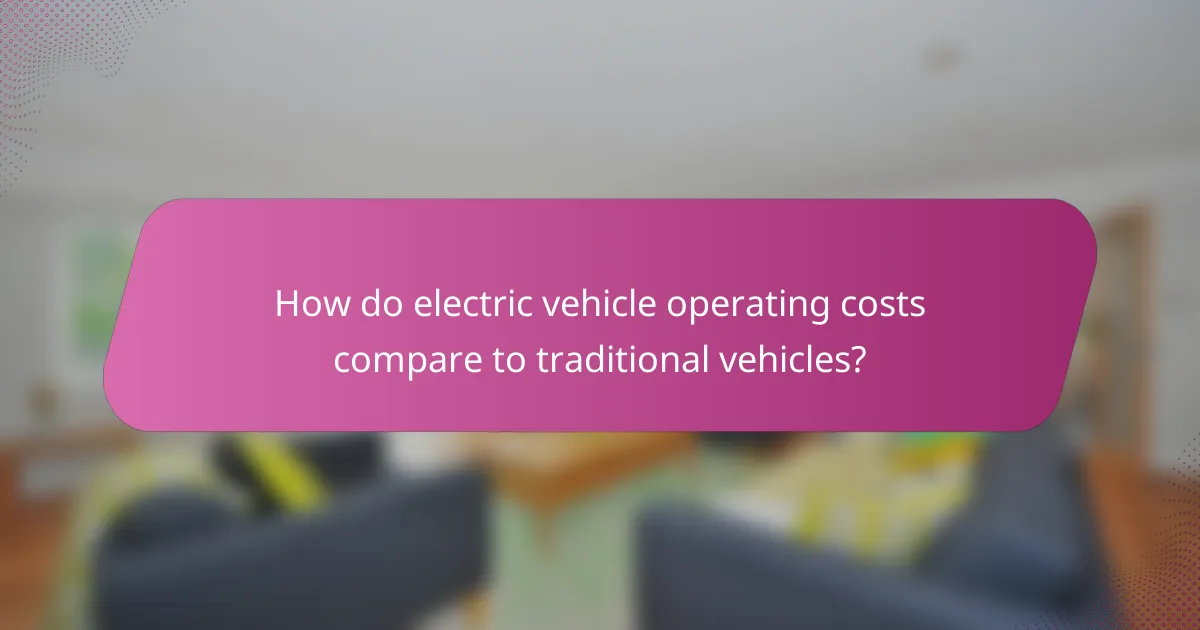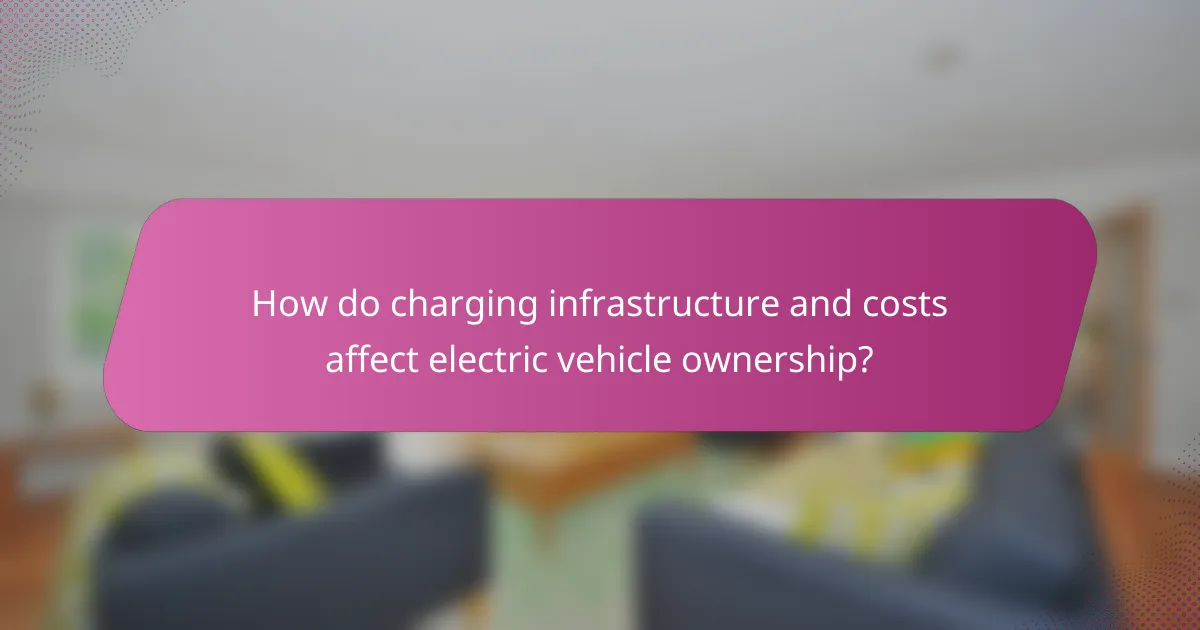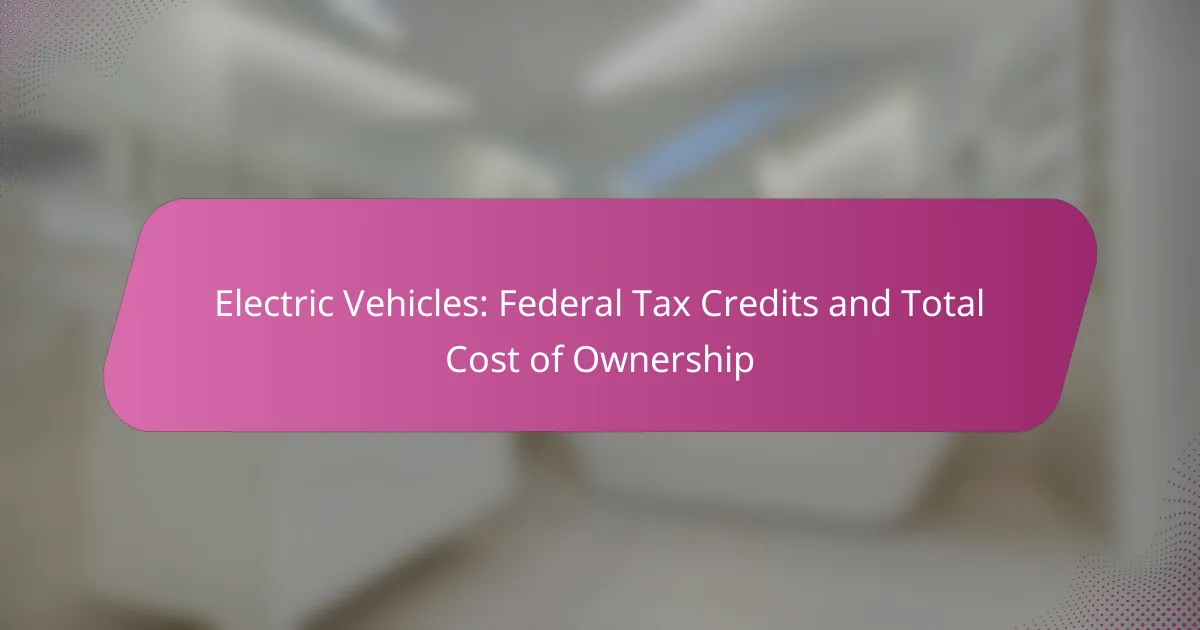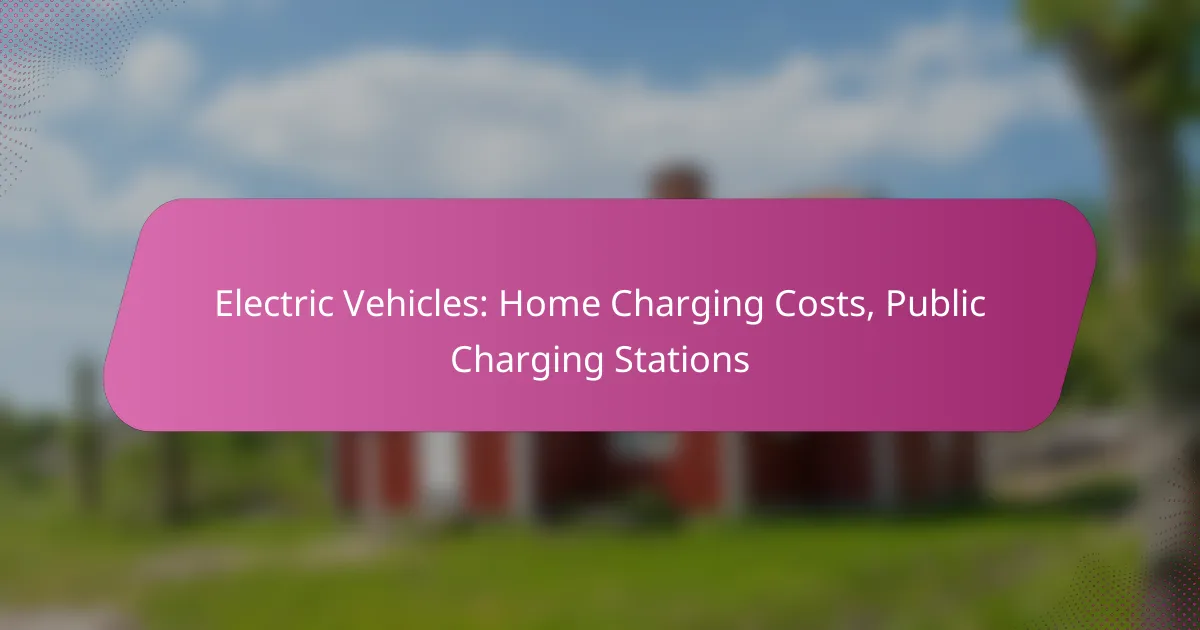Federal tax credits for electric vehicles (EVs) play a crucial role in making them more affordable for consumers by significantly lowering the initial purchase price. These credits not only enhance the financial accessibility of EVs but also contribute to long-term savings, influencing the total cost of ownership by affecting factors such as depreciation, insurance, and maintenance expenses.

What federal tax credits are available for electric vehicles in the US?
In the US, federal tax credits for electric vehicles (EVs) can significantly reduce the overall cost of purchasing an EV. These credits vary based on vehicle type and manufacturer, with the potential to save consumers thousands of dollars.
Federal EV Tax Credit Overview
The federal EV tax credit is designed to incentivize the purchase of electric vehicles by providing a tax reduction based on the vehicle’s battery capacity. This credit can be claimed when filing federal income taxes and is non-refundable, meaning it can only reduce tax liability to zero but not result in a refund.
As of 2023, the maximum credit amount is $7,500, but the actual amount may vary depending on specific vehicle qualifications and the buyer’s tax situation. It’s essential to check the latest IRS guidelines to confirm eligibility and credit amounts.
Eligibility Requirements
To qualify for the federal EV tax credit, the vehicle must meet certain criteria, including being a new electric vehicle and having a battery capacity of at least 4 kilowatt-hours. Additionally, the vehicle must be purchased for use, not for resale.
There are also limits based on the manufacturer’s sales. Once a manufacturer sells 200,000 qualifying vehicles, the credit begins to phase out. Therefore, checking the current status of the manufacturer is crucial before making a purchase.
Credit Amounts by Vehicle Type
The federal tax credit amount can differ based on the type of electric vehicle. For fully electric vehicles, the maximum credit is typically $7,500, while plug-in hybrid electric vehicles may qualify for a reduced amount, often around $2,500 to $4,500, depending on their battery size.
Some vehicles may also have additional incentives based on their specific features or energy efficiency ratings. It’s advisable to consult the IRS website or a tax professional to understand the exact credit applicable to a specific vehicle model.

How do federal tax credits impact the total cost of ownership?
Federal tax credits significantly reduce the total cost of ownership for electric vehicles (EVs) by lowering the initial purchase price and enhancing long-term savings. These credits can offset a substantial portion of the vehicle’s cost, making EVs more financially accessible for consumers.
Reduction in Initial Purchase Price
Federal tax credits can lower the upfront cost of electric vehicles by thousands of dollars. For instance, in the United States, buyers may qualify for tax credits ranging from $2,500 to $7,500 depending on the vehicle’s battery capacity and the manufacturer’s sales volume.
This reduction in initial purchase price can make EVs more competitive with traditional gasoline vehicles. It’s essential to check eligibility for these credits, as they can vary based on income levels and vehicle specifications.
Long-term Savings Analysis
In addition to the initial savings, federal tax credits contribute to long-term savings through lower operating costs. Electric vehicles typically have lower fuel costs compared to gasoline vehicles, with electricity prices often being significantly lower than fuel prices per mile driven.
Furthermore, EVs generally require less maintenance due to fewer moving parts, which can lead to additional savings over time. When considering the total cost of ownership, it’s crucial to factor in these ongoing savings alongside the initial tax credits to get a complete financial picture.

What are the key factors affecting the total cost of ownership for electric vehicles?
The total cost of ownership (TCO) for electric vehicles (EVs) is influenced by several key factors, including depreciation rates, insurance costs, and maintenance expenses. Understanding these elements can help potential buyers assess the long-term financial implications of owning an EV.
Depreciation Rates
Depreciation rates for electric vehicles tend to be higher than for traditional gasoline cars, primarily due to rapid advancements in technology and market competition. Generally, EVs can lose around 50-60% of their value within the first five years, but this can vary based on the model and market demand.
When considering an EV, it’s crucial to research specific models and their historical resale values. Some brands, particularly those with strong reputations for reliability and performance, may retain value better than others.
Insurance Costs
Insurance costs for electric vehicles can be higher than for conventional vehicles, often due to the higher replacement costs of EV components, such as batteries. On average, EV insurance premiums can be 10-20% more expensive, depending on the vehicle’s make and model.
To manage insurance expenses, compare quotes from multiple providers and consider factors like safety ratings and available discounts for electric vehicles. Some insurers offer specialized coverage options that can help reduce overall costs.
Maintenance Expenses
Maintenance expenses for electric vehicles are typically lower than for traditional vehicles, as EVs have fewer moving parts and do not require oil changes. Owners can expect to spend about 30-50% less on maintenance over the lifespan of the vehicle.
However, it’s important to account for potential costs related to battery replacement, which can be significant. Regular checks and software updates are also essential for optimal performance, so budgeting for these aspects is advisable.

How do electric vehicle operating costs compare to traditional vehicles?
Electric vehicles (EVs) generally have lower operating costs compared to traditional gasoline vehicles. This is primarily due to savings in fuel and maintenance, which can significantly reduce the total cost of ownership over time.
Fuel Savings
Electric vehicles typically cost less to fuel than traditional vehicles. The average cost of electricity for charging is often lower than gasoline prices, especially in regions with favorable electricity rates. For instance, charging an EV might cost around $0.10 to $0.20 per kilowatt-hour, translating to a fuel cost of about $3 to $5 for a full charge, which can provide a range of 200 to 300 miles.
In contrast, gasoline prices fluctuate but can average around $3 to $4 per gallon. Given that traditional vehicles average around 25 miles per gallon, fueling a similar range would cost approximately $24 to $48. Over time, these fuel savings can add up significantly, making EVs a more economical choice.
Maintenance Savings
Electric vehicles often incur lower maintenance costs than their gasoline counterparts. EVs have fewer moving parts, which reduces the likelihood of mechanical issues and the need for regular maintenance services such as oil changes. Typical maintenance costs for EVs can be 30% to 50% lower than those for traditional vehicles.
For example, while a gasoline vehicle may require regular servicing every 5,000 to 7,500 miles, an electric vehicle can often go 10,000 to 15,000 miles between services. Additionally, EVs do not require exhaust system repairs or fuel system maintenance, further contributing to their cost-effectiveness over time.

What incentives exist at the state level for electric vehicle buyers?
State-level incentives for electric vehicle buyers can significantly reduce the overall cost of purchasing an electric vehicle (EV). These incentives vary widely by state and may include tax credits, rebates, and grants designed to encourage the adoption of electric vehicles.
State-Specific Tax Credits
Many states offer tax credits that can directly reduce the amount of state income tax owed by EV buyers. These credits often range from a few hundred to several thousand dollars, depending on the state and the vehicle’s specifications.
For example, California provides a tax credit that can go up to $2,500 for eligible electric vehicles, while New York offers a credit of up to $2,000. It’s essential to check your state’s Department of Revenue or equivalent agency for specific eligibility requirements and application processes.
Rebates and Grants
In addition to tax credits, some states provide rebates or grants that offer immediate financial assistance to EV buyers. These rebates can often be applied at the point of sale, reducing the purchase price of the vehicle upfront.
For instance, Colorado offers a rebate of up to $5,000 for electric vehicle purchases, while New Jersey has a program that provides rebates of up to $4,000. Buyers should research local programs and ensure they meet any criteria to qualify for these financial incentives.

How do charging infrastructure and costs affect electric vehicle ownership?
Charging infrastructure and associated costs significantly influence the overall experience of owning an electric vehicle (EV). The availability of home charging options and public charging stations, along with their costs, can impact convenience, accessibility, and total cost of ownership.
Home Charging Installation Costs
Installing a home charging station can range from a few hundred to several thousand dollars, depending on the complexity of the installation and the type of charger. Basic Level 1 chargers may cost less, while Level 2 chargers, which are faster and more efficient, typically require a higher investment.
Homeowners should consider factors such as electrical upgrades, permitting, and installation labor when budgeting for a home charging station. In some regions, local incentives or rebates may help offset these costs, making home charging more affordable.
Public Charging Fees
Public charging fees can vary widely based on location, charger type, and payment methods. Some charging stations offer free charging, while others may charge by the hour or per kilowatt-hour, with costs typically ranging from $0.10 to $0.50 per kWh.
When using public chargers, it’s essential to factor in potential membership fees for networks that offer lower rates. Additionally, consider the availability of fast chargers, which can significantly reduce charging time but may come with higher fees.

What are the future trends in electric vehicle tax credits and ownership costs?
Future trends in electric vehicle (EV) tax credits and ownership costs are likely to evolve as government policies and technologies change. Expect potential adjustments in federal incentives and a shift in total cost of ownership due to advancements in EV technology and market dynamics.
Potential Changes in Federal Policy
Federal policies regarding electric vehicle tax credits are subject to change based on legislative priorities and budget considerations. Recent discussions have included extending existing credits or introducing new incentives aimed at increasing EV adoption. Monitoring these developments is crucial for potential buyers as they can significantly affect the overall cost of purchasing an EV.
For instance, the current federal tax credit can offer up to $7,500 for eligible electric vehicles, but this amount may vary with new regulations or changes in vehicle eligibility. Keeping abreast of policy changes can help consumers maximize their savings.
Emerging Technologies Impacting Costs
Advancements in battery technology and manufacturing processes are key factors that will influence the total cost of ownership for electric vehicles. Innovations such as solid-state batteries promise to enhance efficiency and reduce costs, potentially lowering the price of EVs in the coming years.
Additionally, the integration of smart technologies, such as improved charging solutions and energy management systems, can further decrease operational costs. Consumers should consider these technological trends when evaluating the long-term financial implications of owning an EV.
Market Trends in EV Adoption
The market for electric vehicles is experiencing rapid growth, driven by increasing consumer interest and environmental concerns. As more manufacturers enter the EV market, competition is likely to lead to lower prices and more diverse options for consumers.
Furthermore, the expansion of charging infrastructure and government incentives is making EV ownership more accessible. Understanding these market trends can help potential buyers make informed decisions about their investments in electric vehicles.



